In some ways it’s like a contemporary, high-end version of a cottage industry. When Mike McMahon and Jewlsy Mathews were building up their architecture, interiors, landscapes and furniture studio in London, their own home – a King’s Cross apartment rather than an actual cottage – was their lab.
They transformed the 90sq m “very standard” two-bed apartment on the second floor of a London mews, with good light and space, into a three-bed, with significant smart storage, plus two luxuriant “junglette” balconies, off the living area and main bedroom; they’re making a version for this year’s RHS Chelsea Flower Show. They designed and built – inside the flat and in the courtyard – the majority of the beautiful, innovative furniture, artwork and cabinetry. Each piece was effectively a prototype, learning from the making process, finalising the design.
Mike McMahon Studio offices are in Westminster, but we meet via video-link in their home, a showcase of design solutions for a calm, ordered life that’s both visually striking and practical, and informs the practice.
“Pretty much every room bar the toilet has bookshelves,” says McMahon. “We’ve built storage in nooks and seats all over the place”, so instead of “a ledge where random stuff gathers” there’s space to store and avoid clutter. Attics can attract things you’ve outgrown or replaced, where “it remains there until you’re dead”. With less space in a flat, “we have a one-in, one-out policy. We don’t have anything extra to what we need.”
He points out the nook he designed and built, a combination of aesthetics and utility. “I’ve never had someone come to our home who didn’t like having a look at our nook. It seems to make people happy in the same way as looking out on to a beautiful garden just elevates the soul temporarily.”
That nook is a thing of beauty, incorporating deep seating to stretch into, with bookshelves adjacent, all framed and created by cupboards of varying dimensions. “It’s like a 3-D Mondrian painting.”
The shapes aren’t arbitrary – but specifically built to store ironing board, ladder, duvets. The back is red concrete, cast against timber shutterwork for an interesting surface texture. The doors are white melamine on plywood, bouncing light into the flat from the adjacent window.
In contrast to “those massive, massive houses” in the countryside, aspiring for “bigger, better, and a massive driveway”, he says “you can create so much interest in the tiniest of spaces. That nook is an amazing space to sit and have your coffee, but it’s also multifunctional. All our storage is in there, the boring stuff of life. Sometimes I go into rooms that are huge and you can see people really don’t know what to do with them, and they’re spending so much money heating the space. Sometimes it’s hard to visualise a plan if you’re not an architect.”
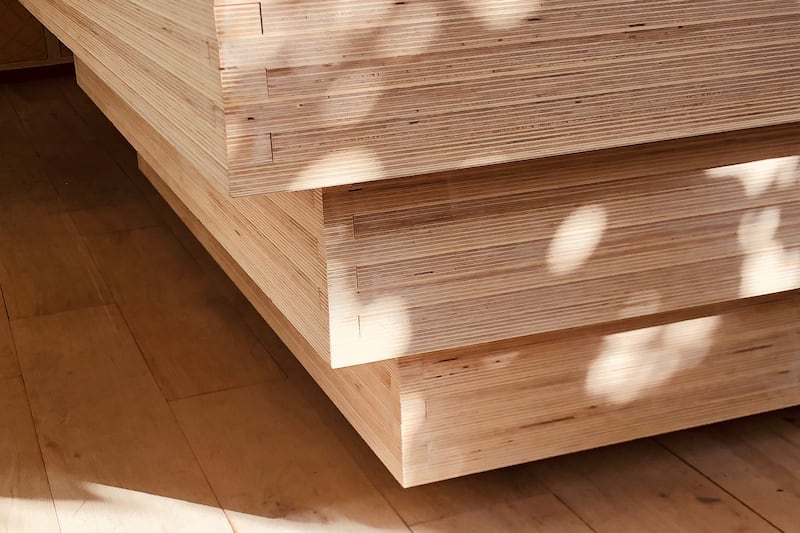
McMahon, from Navan, Co Meath, is a multidisciplinary architect and designer, with 20 years’ experience and a passion for furniture design and making. He studied architecture in Glasgow, worked in Dublin briefly and in 2007 moved to London, where he met Mathews, with an eclectic background from optometry to anthropology to product development. He was an associate at Eric Parry Architects for a decade, running multiple large projects, before leaving just 14 months ago to set up Mike McMahon Studio with Mathews.
“It was a difficult decision to leave my practice because I really enjoyed working there. But it’s something I’ve wanted to do for years. It’s definitely the right decision. We thoroughly enjoy working together. And it’s just been lovely, exploring loads of different ideas, in architecture, our furniture, gardens. It’s just been amazing.”
The new practice provides architectural and interior design services, currently working on projects from a large office building in London to a Clontarf garden.
In his spare time, McMahon is also a stand-up comedian (must be something in the water in Navan, where Dylan Moran and Tommy Tiernan also grew up), gigging in London and internationally – though he only does comedy on occasion now as he’s so busy with their new practice. “I really enjoyed performing, as it was amazing bringing audiences on a journey. I used to find there was a strong link between design and comedy, as at the end of the day each of my gigs was based on a concept which would end up being a full critique on something very random.”
Their home is filled with thoughtful furniture, both in concept and utility. The striking Unfurl chair, reminiscent of fern fronds unfurling, is made from recycled paper and inspired, like many McMahon designs, by the intricacies of fractal geometry (a small element repeating itself at larger scales). Crafted from durable, eco-friendly Richlite material, the compressed recycled paper with 26 individual profiles expands and contracts to support the person, cantilevering out. It was shortlisted for the Irish Design Awards last year, and there’s also a plywood version.
Their nine-year-old son Milo’s bed is a climb-up affair with stacked cupboards as steps, and a shutter. The doors of Stereopsis, a credenza (sideboard) influenced by Bridget Riley’s art, comprise hundreds of pieces of curved plywood.
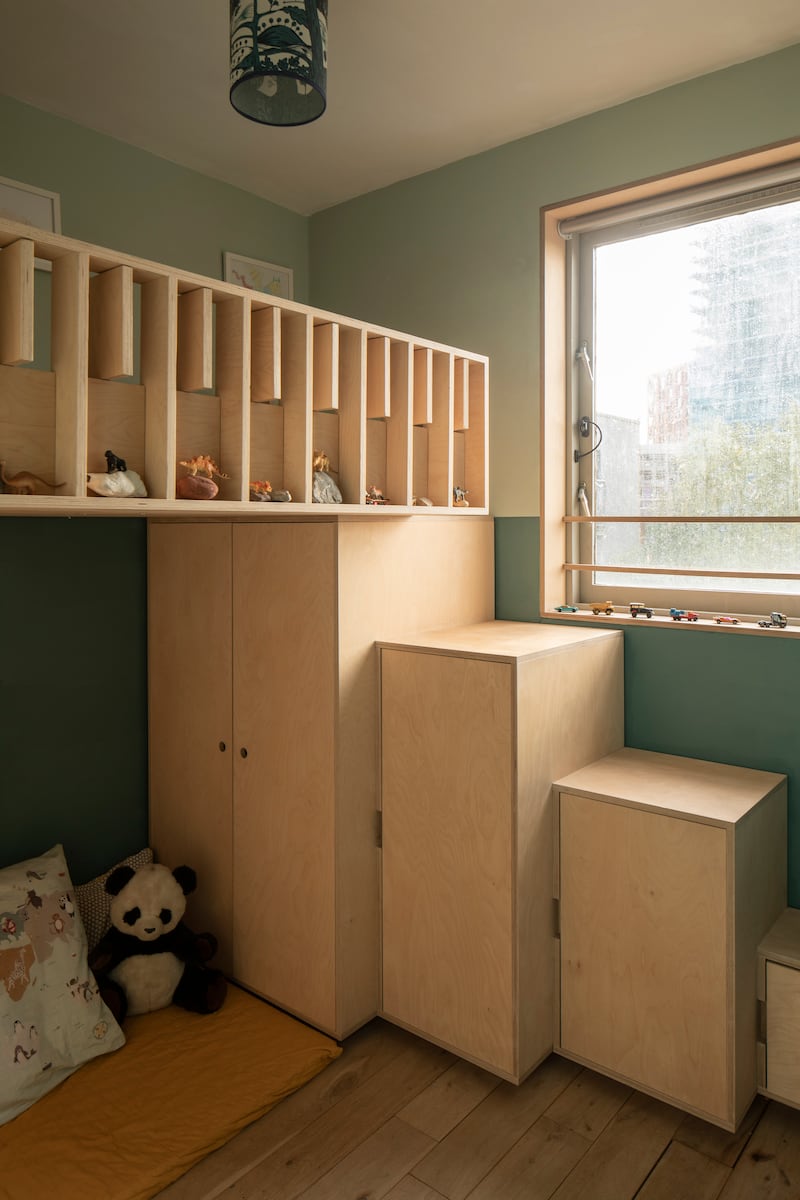
Next month they’re launching several pieces of furniture, made to order from the UK via mikemcmahonstudio.com, and hope to sell in Ireland later this year.
Mathews observes “you can almost see the physical journey, the evolution of thought process” in making individual pieces on a walk-through of their flat. “When we’re showing people, I see it with new eyes. And it’s surprisingly linear, obviously little deviations, but this piece informed this, informed this, and then we pivoted.”
McMahon and Mathews’ personal and professional lives are entwined, working and living together, and living amid their work. That mode started early for McMahon, whose first real-life architectural project was designing his parents’ new house in Navan, when he was a 21-year-old student, and they had to demolish because of differential settlement.
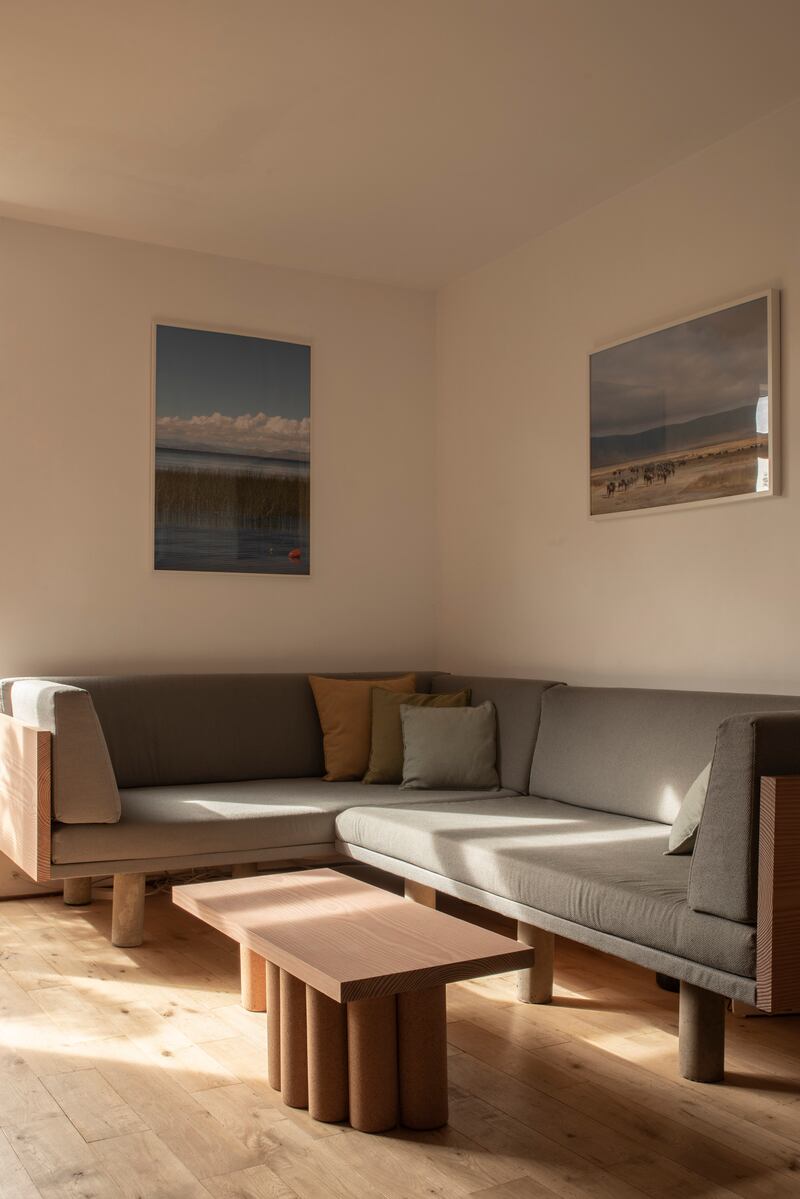
His parents’ trust and confidence in him paid off. He recalls his dad ringing him in university one day from the new house. “He said, I’m in the hallway. There’s light flooding down into the hallway. Did you know there was going to be light in here? I said, can you just look up and describe what you see. He said, I can see loads of windows. I said, I had a rough idea the light would come in through those windows. I think they both love living in the house, because it’s very special to be in a home designed by their child.”
Clearing their attic before demolition, he found a 1950s photograph taken in the Aran Islands, with his great-uncle and a currach. That currach shape later inspired their curved birch plywood dining table, with a recessed fruit bowl.
Though their home has only what they need, Mathews says “nostalgia and heritage is really important to both of us”. She points out a favourite artpiece. Her father’s house in the backwaters of Kerala, India, is 200 years old. “My dad took Mike into the attic to help with an old box” and from an old wicker basket he produced the original 200-year-old house-deeds, inscribed in Malayalam on palm leaves; some are framed, on their London wall.
The flat originally had “an awful poky afterthought of a kitchen”, says Mathews, “a real bugbear because I love cooking. Being in the kitchen, having people around, is a huge part of our lives. To me the whole flat is wonderful, but the kitchen was the key thing. I would say it’s entirely life-changing to have a well thought-out kitchen, communal, with enough space for everything nearby, but also clutter free.” It’s full of nifty ideas, like pulldown plug sockets, so the splashback (“really tactile, beautiful tiles” made by pressing folded paper into porcelain) isn’t peppered with them.
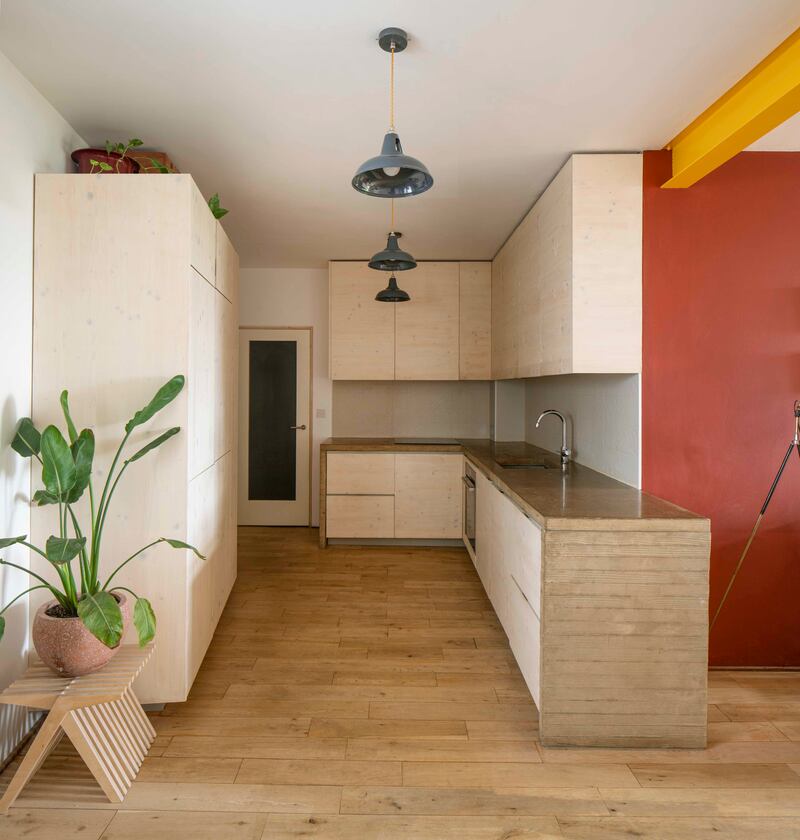
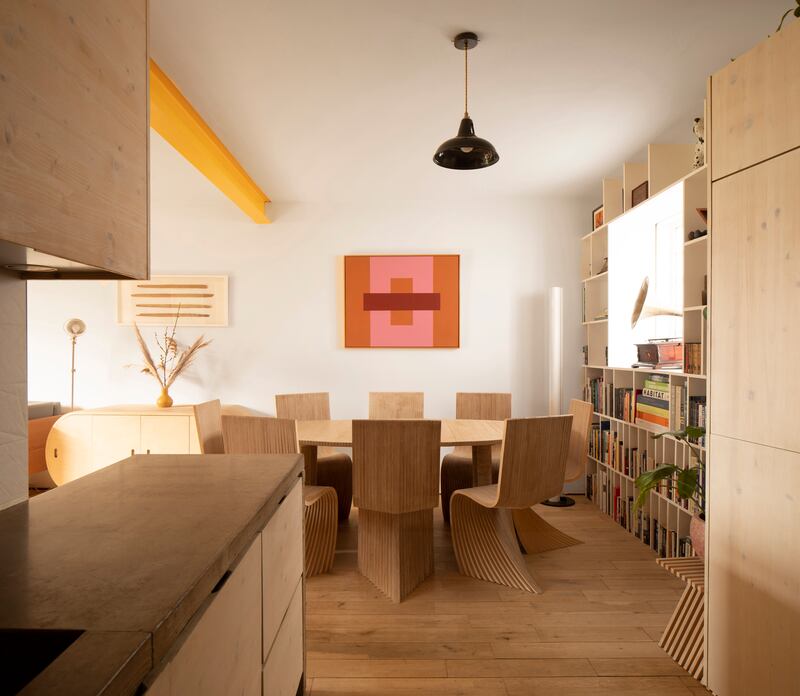
“I’ve been gardening since I was seven or eight,” says McMahon, adding it wasn’t something you broadcast in school in 1980s Ireland. He has childhood memories of BBC’s Gardeners’ World advice about leaving space around plants. “I have just completely discarded those guidelines for here and we have stuffed tons in!” Their “junglette” balconies have “tree ferns, a banana tree, Tetra Panax. I even had a Gunnera at one point”, recommended for large gardens, before the snow got it one year when it wasn’t covered. “The thing about balconies that people don’t realise is there’s huge overhang space where plants can extend outward.” In their one x two-metre balconies, overlooking a courtyard, “every inch is covered” with exotic, exuberant foliage, providing privacy for lounging, but also natural solar shading for the flat during hot London summers.
They’re currently working on a larger (5mx2m) version, the Addleshaw Goddard Junglette Garden, for RHS Chelsea Flower Show. As well as designing, they’re building it themselves, from furniture to planting to a large folded back-wall of recycled paper, made from 1,492 pieces which “we’re assembling like a 3D jigsaw”. The wall has four patterns, replicating forest levels from canopy to forest floor. The folds give extra levels of depth, repeating itself, like a fern’s fractal geometry.
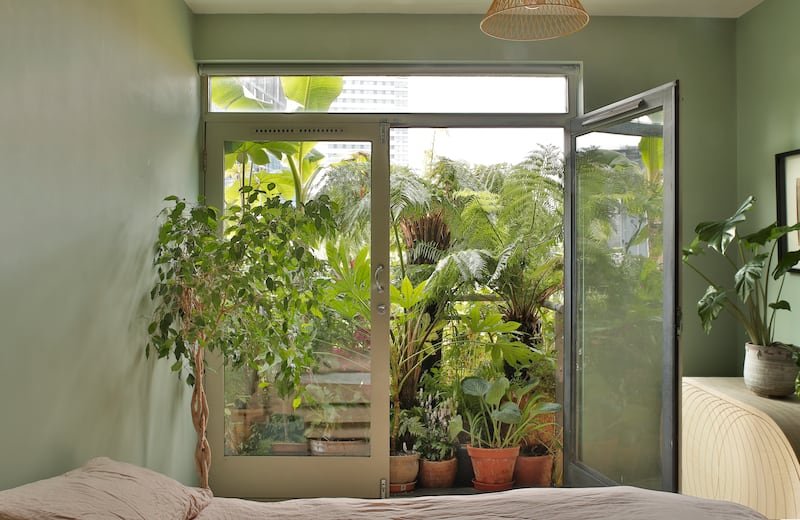
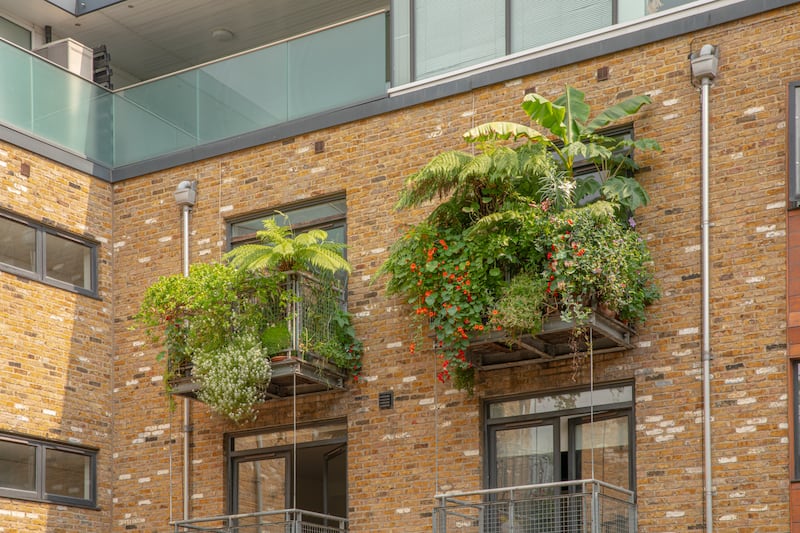
Mathews says a key aim is to show balconies’ potential. In King’s Cross “as I look out the window, hundreds of balconies have not a speck of anything on them. They’re isolated, forgotten spaces” occasionally used for smoking, or extra storage. “Where most people see balcony railings ... Mike sees trellis, a path plants can grow up.”
They’re passionate about sustainability. Milo’s bed-structure comprises modules that can be taken apart and reconfigured, “because the next room my son lives in won’t be the same dimensions”. He points out a credenza he built, with a storage heater behind it, and slots to release hot air; it’s designed so if they move, a panel unscrews to reconfigure it without heater. The Chelsea garden’s hard landscaping is designed so the big oval deck will afterwards become a dining table, its second life.
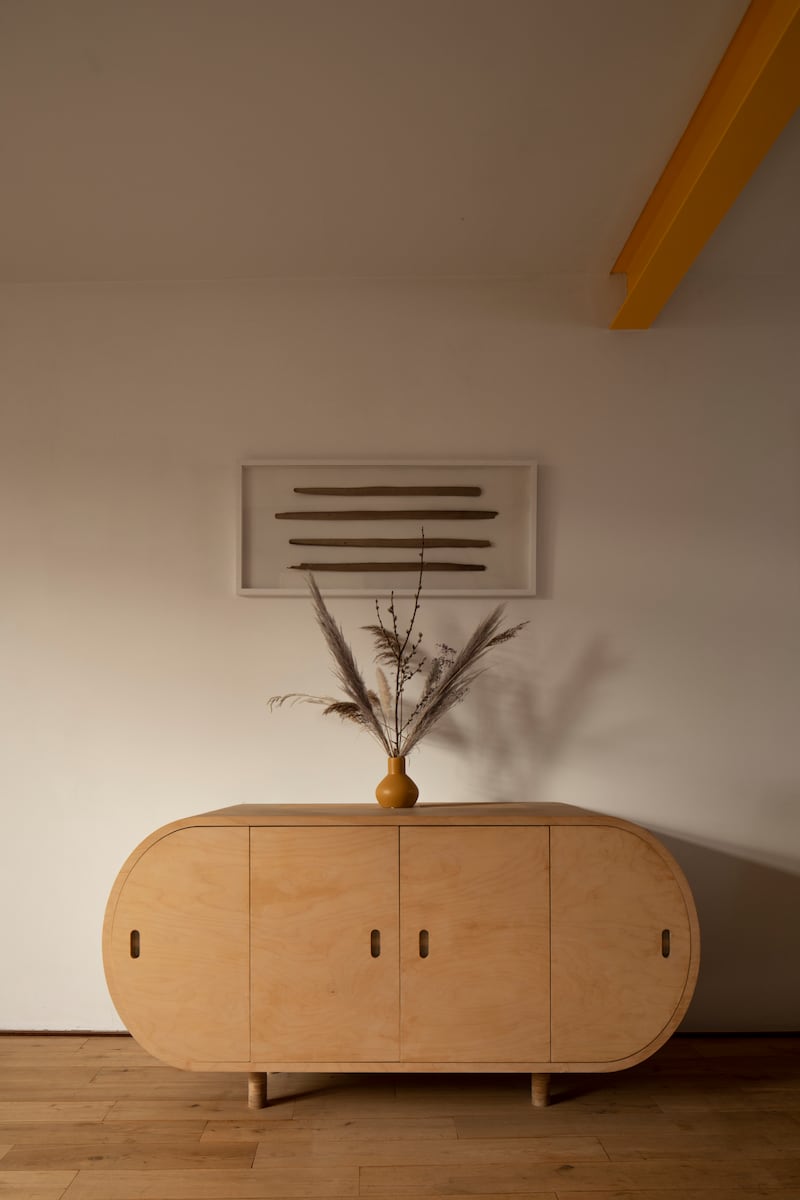
It’s critical for designers now, says McMahon, “to think for the now, the future, and beyond. So it’s not going like that flat-pack furniture, into a skip. Because we only have one planet, and limited resources.” mikemcmahonstudio.com
- Listen to our Inside Politics Podcast for the latest analysis and chat
- Sign up for push alerts and have the best news, analysis and comment delivered directly to your phone
- Find The Irish Times on WhatsApp and stay up to date

















